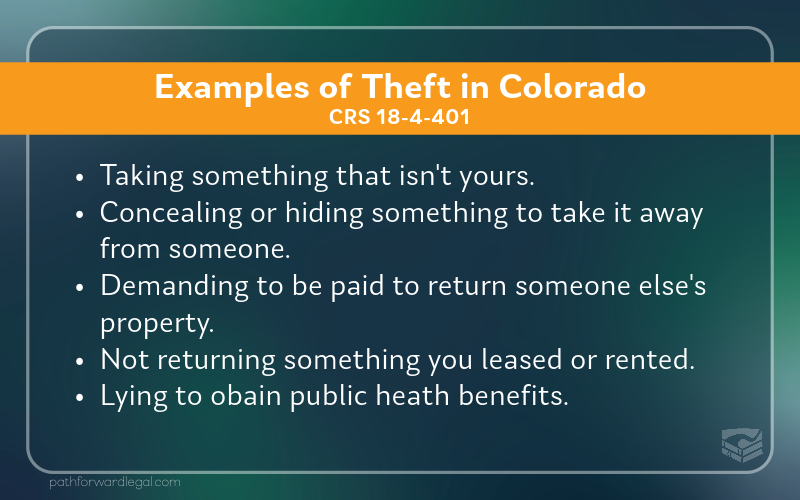Theft is a crime that has a broad range of implications, affecting both the victims and the perpetrators. In Colorado, theft crimes can range from petty offenses to serious felonies.
Colorado theft laws are defined in Title 18, part 4 of the Colorado Revised Statutes. Each section may have multiple grades or categories of theft, each with their own penalties. Services, rental property, and even lift tickets can be subject to theft under Colorado Revised Statutes.
The crimes under the “Theft” section are:
However, when most people think about theft, they are talking about CRS 18-4-401. There are many ways that someone can commit theft under this statute. These ways all require someone to get, keep, or control someone else’s property. It doesn’t matter if you took something without authorization or you obtained authorization fraudulently.
It’s theft if there was intent to deprive someone permanently of the property. It is also theft if you demand that someone pay you money in order to return an item that is not yours.

(1) A person commits theft when he or she knowingly obtains, retains, or exercises control over anything of value of another without authorization or by threat or deception; receives, loans money by pawn or pledge on, or disposes of anything of value or belonging to another that he or she knows or believes to have been stolen, and:
(a) Intends to deprive the other person permanently of the use or benefit of the thing of value;
(b) Knowingly uses, conceals, or abandons the thing of value in such manner as to deprive the other person permanently of its use or benefit;
(c) Uses, conceals, or abandons the thing of value intending that such use, concealment, or abandonment will deprive the other person permanently of its use or benefit;
(d) Demands any consideration to which he or she is not legally entitled as a condition of restoring the thing of value to the other person;
(e) Knowingly retains the thing of value more than seventy-two hours after the agreed-upon time of return in any lease or hire agreement; or
(f) Intentionally misrepresents or withholds a material fact for determining eligibility for a public benefit and does so for the purpose of obtaining or retaining public benefits for which the person is not eligible.

When someone is charged with “theft,” it usually means that they’ve been charged with violating CRS 18-4-401. There are six types of theft under this statute, and this doesn’t take into account the value of the item.
To make things more complicated, each type of theft can be committed in two ways. The first is by obtaining, retaining (keeping), or exercising control of anything of value. The second is theft by receiving, disposing of, or loaning money based on the item. So, it doesn’t matter if you take an item, receive an item, or get rid of an item. If it’s something you knew was owned by another person, that’s the first part of theft.
The many ways that theft can be committed under the statute mean that it’s even more important to consult an attorney if you are accused of theft. Every case is different, and it’s impossible to give an example of every variation of theft that would fit the statute language. That said, here are some examples of common ways theft can be committed:
A person takes a computer that was sitting on a table in a coffee shop and puts it in their bag.
This meets the definition of “theft by intent to permanently deprive.” The elements that need to be proven include that the person:
A person goes to a table where there is a computer and places their coat over it. The owner of the computer comes up and asks if there was a computer there. The person says “no” and the computer’s owner leaves, believing the computer to be stolen by someone else.
In this case, the concealment of the computer is theft. The elements that need to be proven include that the person:
A person goes to a table where there is a computer and sits down. The owner of the computer comes up and asks for their computer back. The person says, “Sure, just give me $100, and I’ll give it to you.”
In this case, there would be a hard time proving that sitting at the table meant that the person wanted to keep the computer. That’s why there is another way of committing theft: demanding money to return something that isn’t yours. The elements that need to be proven for this is that the person demanding the money:
A person applying for a mortgage to buy a home puts in their application that they make $1,000,000 a year when they know they only make $50,000 a year. They get the mortgage and move into the home.
In the case of the lying home-buyer, lying on a mortgage application is considered theft that can be prosecuted by the state’s Attorney General or the district attorney in the relevant county. The elements that need to be proven for theft by deception are that the defendant:
As you can see, the elements are the same as taking something that isn’t yours, but instead of taking without authorization, it’s a taking by deception. It doesn’t matter that the person who originally owned the home was not the person who was deceived (the bank was). This is also called theft by false pretenses.
Theft involves taking another’s property. Burglary involves entering a building unlawfully with the intent to commit theft or another crime. Robbery involves the use of force or threat to take property. Each of these crimes is distinct and carries its own set of penalties under Colorado law. For a full list of Colorado laws, including theft, burglary, and robbery, see our directory.

For a CRS 18-4-401 theft offense, the penalty depends on the value of the thing stolen. However, a theft of an item worth less than $2000 can be a felony when other factors are present.
If the value of the thing is less than $300, then the theft is a petty offense.
There are two classes of misdemeanor in Colorado. Theft is a Class 2 misdemeanor if the value of the thing is between $300 and 1000 dollars. Theft is a Class 1 misdemeanor if the value is between $1000 and 2000 dollars. There is no longer a Class 3 misdemeanor in Colorado, but it was a type of theft prior to 2022.
Felony theft occurs when the value of the stolen property exceeds $2,000. It’s sometimes referred to as “grand theft,” though it’s more often referred to by the class of felony. The severity of the felony charges depends on the value of the stolen items and other circumstances of the theft.
Regardless of the amount taken, if the theft is “from the person of another by means other than the use of force, threat, or intimidation,” then it is a Class 5 felony. Simply put, if you steal something from a person’s body (like pick-pocketing), it’s a felony regardless of the value of the item.
The penalties for a theft felony offense can include years in prison, restitution (paying back what was stolen), and fines. Though each class of felony has a presumptive penalty, the actual time someone faces for criminal charges depends on their criminal record, the type of stolen property, and the way the theft occurred.
It’s challenging to comprehend theft laws in Colorado because of the broad range of activities that fall under the category of theft and the varying penalties for each. Whether it’s petty theft or felony theft, the implications on both personal and professional levels can be significant. Being equipped with the right information is the first step in navigating the legal landscape surrounding theft charges.
If you or someone you know is dealing with theft charges in Colorado, it’s essential to seek guidance from a skilled lawyer who can offer tailored advice for your situation. At Path Forward Legal, we are dedicated to offering comprehensive legal counsel and representation to ensure the best possible outcome for our clients. We invite you to contact us for a confidential consultation to discuss your case and explore the path forward toward resolution.

